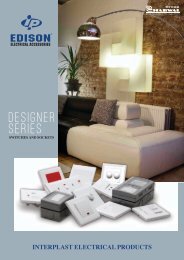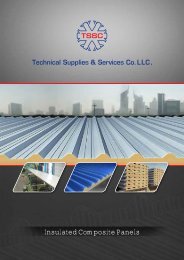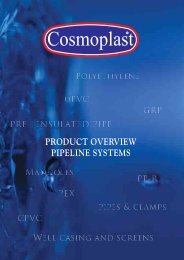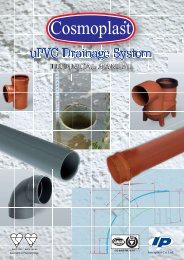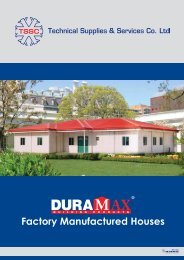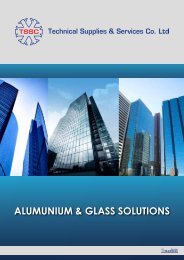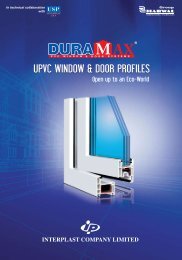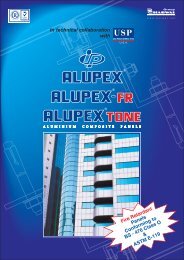HDPE Drainage Pipes - Harwal.net
HDPE Drainage Pipes - Harwal.net
HDPE Drainage Pipes - Harwal.net
You also want an ePaper? Increase the reach of your titles
YUMPU automatically turns print PDFs into web optimized ePapers that Google loves.
Cosmoplast PE Soil, Waste & Vent SystemIntroductionCosmoplast <strong>HDPE</strong> drainage system is the ultimate solution for all types of drainage including soil and waste,above ground, below ground and chemical waste.Cosmoplast <strong>HDPE</strong> drainage system is suitable for residential and industrial buildings, for laboratories,embedded in concrete or buried underground.Cosmoplast <strong>HDPE</strong> pipes and fittings are available in sizes from diameter 32 mm to 315 mm. Bigger sizes canalso be fabricated on request.MaterialHigh-density polyethylene (<strong>HDPE</strong>) is suitable for producing drainage pipes and fittings for residential andindustrial buildings for non-pressure waste at maximum temperatures of 95°C.The <strong>HDPE</strong> material is characterized by:• High flexibility.• High impact strength.• Excellent mechanical characteristics.• High corrosion resistance.• High chemical resistance.• Recyclable material.Physical & mechanical properties of <strong>HDPE</strong> materialProperty Test Method Units PE 80 PE 100Density (Compound) ISO 1183 Kg/m³ 956 959Melt Flow Rate(190ºC/5kg) ISO 1133 g/10 min 0.3 0.25Tensile Stress at Yield(50mm/min) ISO 527-2 MPa 22 25Elongation at Break ISO 527-2 % > 600 > 600Charpy Impact Strength, notched ISO 179/1eA kj/m² 14 16Carbon Black Content ASTM D 1603 % 2 2Vicat Softening Point ASTM D 1525 ºC 118 122Brittleness Temperature ASTM D 746 ºC < -70 < -70ESCR (10% Igepal), F50 ASTM D 1693A Hrs. >10,000 >10,000Thermal Conductivity DIN 52612 W/mºK 0.4 0.4Linear Thermal Expansion ASTM D 696 Kˉ¹ 1.5x10ˉ4 1.5x10ˉ41
Standards:Cosmoplast <strong>HDPE</strong> drainage pipes and fittings are manufactured according to the European StandardEN1519-1which superseded the German Standards DIN19535-1 and DIN19535-2 .Dimensions of <strong>HDPE</strong> drainage pipes according to EN 1519-1Nominal OutsideDiameter (mm)Notes:Series 16 (S 16) is suitable for application area inside buildings and outside buildings fixed on the wall(application area B).Series 12.5 (S 12.5) is suitable for application area under and within 1metre from the building where the pipesand fittings are buried underground and connected to the soil and waste discharge system of the building(application area D).Characteristics and Advantages of Cosmoplast <strong>HDPE</strong> <strong>Drainage</strong> System:Long Durability:Mean OutsideDiameter (mm)Wall Thickness(mm)Wall Thickness(mm)Series S 16 ** Series S 12.5Min Max Min Max Min Max32 32.0 32.3 3.0 3.5 3.0 3.540 40.0 40.4 3.0 3.5 3.0 3.550 50.0 50.5 3.0 3.5 3.0 3.556 56.0 56.5 3.0 3.5 3.0 3.563 63.0 63.6 3.0 3.5 3.0 3.575 75.0 75.7 3.0 3.5 3.0 3.580 80.0 80.8 3.0 3.5 3.1 3.690 90.0 90.9 3.0 3.5 3.5 4.1100 100.0 100.9 3.2 3.8 3.8 4.4110 110.0 111.0 3.4 4.0 4.2 4.9125 125.0 126.2 3.9 4.5 4.8 5.5160 160.0 161.5 4.9 5.6 6.2 7.1200 200.0 201.8 6.2 7.1 7.7 8.7250 250.0 252.3 7.7 8.7 9.6 10.8315 315.0 317.9 9.7 10.9 12.1 13.6Due to its chemical stability and corrosion resistance, Cosmoplast <strong>HDPE</strong> drainage pipes and fittings areexpected to last for up to 50 years.2
High Flexibility:Resulted from the high quality virgin <strong>HDPE</strong> raw material used by Cosmoplast to produce its pipes and fittings.The flexibility of Cosmoplast <strong>HDPE</strong> pipes and fittings guarantees crush resistance and ultimate performancewhen pipes are buried in areas subject to traffic and when passing through expansion joints.High Corrosion Resistance:Resulted from the basic characteristics of the <strong>HDPE</strong> material that ensures high resistance to corrosion.High Chemical Resistance:<strong>HDPE</strong> material has good resistance to acids and excellent resistance to Alkaline and Solvents. HEPE is alsoresistant to wide range of chemicals which renders the <strong>HDPE</strong> drainage system the ultimate solution forchemical and industrial drainage <strong>net</strong>works. The system is insoluble in all inorganic or organic solutions atroom temperature.Low noise system:Thanks to the acoustic insulation feature of the <strong>HDPE</strong> material which helps in reducing the noise level whilesystem is operational. This property makes Cosmoplast <strong>HDPE</strong> drainage system ideal for installations inuniversities, hospitals, hotels…etc.3
High resistance to extreme temperatures:Cosmoplast <strong>HDPE</strong> drainage system can be safely used with fluids athigh temperatures up to 80°C. Short time loading at temperatures upto 100°C is permissible. Cosmoplast <strong>HDPE</strong> drainage system is alsosuitable for subzero temperatures and adapts elastically with expansionand contraction resulted from freezing and defrosting.Strict Quality control:Cosmoplast <strong>HDPE</strong> pipes and fittings are subjected to several in-house quality control tests during productionand on the finished products. They are also subjected to external tests by independent testing institutes toensure the highest quality.High Impact resistance:Cosmoplast <strong>HDPE</strong> is highly resistant to impacts and therefore unbreakable at room temperatures and atsubzero temperatures.Lightweight:Cosmplast <strong>HDPE</strong> drainage system is light in weight compared to the traditional drainage systems which makesit easy for handling, storage and transportation.Smooth internal Surface:<strong>HDPE</strong> pipes and fittings are more resistant to solids build up or scaling.4
Application Areas<strong>Drainage</strong> systems inside buildingsCosmoplast <strong>HDPE</strong> drainage system can be used in residential buildings, commercial buildings, industrialbuildings and laboratories.Installations inside concreteCosmoplast <strong>HDPE</strong> drainage pipes and fittings can be installed inside slaps and concrete thanks to its flexibilityand high abrasion resistance.External and underground drainageCosmoplast <strong>HDPE</strong> drainage pipes and fittings can be installed outside buildings underground thanks to itsflexibility and resistance to crush and abrasion.5
Installation TechniquesCosmoplast <strong>HDPE</strong> drainage pipes and fittings can be jointed in different techniques, as electro-fusion sockets,but fusion sockets, rubber ring (push fit) sockets, and flanged sockets are all applicable for <strong>HDPE</strong> drainagepipes and fittings.Electro-Fusion SocketsThis technique is the ideal jointing method on-site, specifically suitable for installations in tight spaces likemechanical shafts. The process is easy and fast resulting reliable connections. Electro-fusion couplings areused in this process, which are available in sizes from ø 40 to 250 mm.Rubber Ring SocketsThis technique is the ideal solution for compensation of thermal expansion in PE pipes. Rubber ring joints arenot resistant to tension forces.Flanged SocketsThe conventional connection technique connecting <strong>HDPE</strong> pipes with pipes of other materials like metal andUPVC and for connections to tanks and equipments. Flanged joints are resistant to tensile forces.This technique is very rarely used in above-ground drainage installations.6
Butt FusionThis technique is the ideal way for space-saving connections. Semi or fully automatic welding machines areutilized to achieve butt-fusion connections.In this technique, both pipe ends are pressed against a hot plate at a constant temperature and pressure. Thenpipe ends are pressed on head to head situation so that both pipe ends are fused together.Light weight manual butt fusion machines are suitable for on-site installations for small dimensions ø 75 mmand smaller.PICTURE TO BEPROVIDESMore sophisticated automatic butt fusion machines are utilized for bigger dimensions from 50mm to 315 mm.These machines are suitable for fusing prefabricated connections away from the site.7
Pipe Supports and Clamping• All pipework must be adequately supported whether vertical or horizontal.• Plastic pipework expands and contracts with changes in temperature - whether ambient temperatureor from the nature of the discharge through the pipework. Expansion joints must therefore be provided toaccommodate such thermal movement.• Pipe brackets must be used to anchor expansion joints. Intermediate support must also be provided tosteady pipework between the points.• Horizontal pipework requires more frequent support than vertical pipework (for example, soil stocks)• On long suspended soil pipe runs (e.g. in basement areas), sliding joints should be installed to control theeffects of thermal expansion.• Pipework should always be supported close to any change of directions (e.g. bends or branches)• Cosmoplast <strong>HDPE</strong> drainage pipes and fittings should be installed tension free and with free lateralallowance for thermal expansion compensation.• Long runs of pipes should not be used in exposed installations unless some precautions are considered toensure that excessive deformations will not occur in the system due to thermal expansion.• Suitable sound absorbing brackets with rubber lining should be used to support pipes. Those bracketsmust be dimensionally compatible to the pipe diameter.• The fixed bracket creates fixed point in the pipe system. With fixed brackets the pipe or fitting can not bemoved through the bracket after screws are tightened. In order to prevent sliding down of vertical pipes,each individual pipe must be secured on one point by a fixed bracket.• Fixed brackets must be installed directly above the fitting at the bottom of the pipe end. The sliding bracketmust be installed at a distance of maximum of two meters above the fixed bracket.• Every horizontally installed pipe should always be fixed with one fixed bracket. All remaining pipe bracketsin horizontal as well as in vertical installation must be tightened in such a way to allow sliding.8
• During installation of horizontal pipes, the distance between brackets should be approximately ten timesthe outside diameter of the pipe. While for vertical installations, brackets are required every 1 to 2 metersdepending on the size of the pipe.• In general, each expansion socket should be fixed with one fixed point bracket.• The distance between the pipe and the structure to which it is fixed should be kept as small as possible inorder to reduce the movement of the connecting rods.• Pipe brackets should not be installed in areas of diameter reduction and change of directions in thesystem, this is required to allow for thermal expansion.• Pipe brackets should be fixed on building materials with high strength in order to assure strong anddurable pipe fixing.• In multi-story buildings, the drainage pipes of diameter 110mm or bigger installed inside the mechanicalducts must be secured by additional fixing against sliding.TrapsTraps are essential for every discharging unit (wash basin, shower, sink,…etc) in the system. They are requiredto prevent bad smell from leaking inside the house.Trap size should be suitable for the discharging unit to which it will be connected, as small traps will causeslow discharge and may cause self-siphoning in addition to the noise generation.Oversized traps will reduce the flow speed in the trap which makes it difficult to flush the soiling and thereforemay cause blockage.<strong>HDPE</strong> AeratorCosmoplast <strong>HDPE</strong> Aerator with its unique design, enables the reduction of waste speed inside the stacks.9
Advantages and characteristics of Cosmoplast Aerator:• Reduces the speed of waste inside stacks,• Elemenates the negative effect of pressure fluctuations inside the stacks.\• Suitable for high rise buildings (with more than 7 floors) and for applications with high sewage flow rates.• Increases the flow rate in the waste stack by 40 – 50%.• Prevents the return flow from the stakc to the to the branches.• Can be used with <strong>HDPE</strong>, or with PE and PVC stacks when using the special snap sockets.The utilization of Cosmoplast Aerator in the drainage system increases the flow rate of waste inside the thestacks significantly compared to the systems without aerators.Maximum flow rate in stacks:Maximum Flow Rate (I/s)110mm Stack 160mm StackStack without Aerator 4.0 - 5.5 9 - 12.5Stack with Aerator 7.8 - 8.1 18.0 - 18.2The operation of the Aerator:Cosmoplast Aerator with its unique design prevents the direct contact between the waste in the branches fromand the waste falling from the upper floors. This process prevents the negative effect of pressure fluctuationsin the drainage system.Installation of Cosmoplast Aerator:Cosmoplast Aerator can be installed at every floor or every nomber of floors depending on the designconditions.10
Cosmoplast Aerator has 2 front connections and 4 side connections, all can be used simultaneously. Installationswhich enables cross flow are not allowed and should not be used, as demonstrated in the below sketches:The maximum distance between two Aerators is recommended not to exceed 6m. however, in case ofinstallations with distances more than 6m, it is recommended to make speed reduction loop by using four 45ºelbows as demonstrated in the below sketch:The vertical portion should be at least twice the diameter of the stack pipe.11
Underground Installation<strong>HDPE</strong> drainage pipes can be utilized in underground drainage systems. Trenches should be constructedand backfilling materials should be selected as per the local codes of practice. The below are somerecommendations:Fig. 1 “trenching in areas with heavy traffic”Fig. 2 “trenching in residential areas with light traffic”Fig. 3 “trenching inside concrete”12
Recommendations for Backfilling:• Place backfill as soon as the pipes have been bedded, jointed and inspected.• Use granular material or selected backfill from the trench excavation free from1. Stones larger than 40mm.2. Clay lumps larger than 100mm3. Timber4. Frozen material• Compact backfill in layers not deeper than 300mm• Avoid mechanical compaction until fill is at least 450mm above pipe workHandling, Storage and Transportation<strong>HDPE</strong> drainage pipes and fittings should be handled with care considering the resilience of these pipes andfittings. Transportation, storage and handling should be done taking into consideration the below directionsand precautionsHandling• Take all reasonable care when handling <strong>HDPE</strong>, particularly in very cold conditions when the impactstrength of the material is reduced.• Do not throw or drop pipes, or drag them along hard surfaces.• Do not scratch pipes against hard surfaces or drag them along the ground.• In case of mechanical handling, use protective slings and padded supports. Metal chains and hooks shouldnot make direct contact with the pipe.Storage• To avoid deformation over time, pipes should be stacked:» either on a flat base» or on a level ground» or on 75mm x 75mm timber at 1m max. centers.13
• Provide side support with 75mm wide battens at 1m centers.• Maximum stack height is 1.7 meters regardless the pipe diameter.• Store all materials in well-ventilated, shady conditions• Avoid direct exposure to sunlight for long periods.• If stored in the open for long periods or exposed to strong sunlight, cover the stack with opaque sheeting.• keep fittings in original packaging until required for use• Ideally, stacks should contain one diameter pipe size only. Where this is not possible, stack largestdiameter pipes at base of stack. Small pipes may be nested inside larger pipes.• Store fittings under cover. Do not remove from cartons or packaging until required.• Do not place heavy items on top of the pipes.• Protect the pipes from dirt, gravel or mud, as this could damage the ring seals inside the sockets.• <strong>Pipes</strong> should be kept clean as much as possible, as this may save cleaning time while preparing pipes forwelding.• Electro-fusion sockets should be stored indoors inside their original sealed packing to prevent oxidationfrom sunlight, which can badly affect the welding quality.14
TransportWhile transport, pipes should be arranged safely on trucks avoiding crossing, bending and over stacking.The pipes should also be fully supported over their total length.Proper protection should be provided if chains or cords are used to tie down the load in order to avoid damagingthe pipes.Installation: General rules and recommendations:• Pipe sizing must be determined on a section by section basis.• Collecting pipes must straight and short as much as possible.• Change of pipe direction should not be made at angles less than 45° to avoid soil being left behind.• In any section, the sum of changes in direction should not exceed 135°.• Eccentric reducers should be used in the horizontal collecting pipes.• Concentric reducers should not be used on horizontal sections.• Horizontal connections must be made with 45° Y branches.• 90° top connections must be avoided when the horizontal pipes are smaller than 110mm as topconnections may cause flow disturbance and hydraulic sealing in the horizontal pipes.• Stacks should be designed in such a way to prevent hydraulic sealing or excessive pressure differencesat the points of connections with collecting pipes and bends including the points at the foot of the stackswhen connecting to the underground pipes.• <strong>HDPE</strong> aerators should be used every 3- 4 stories to ensure better ventilation in the stacks.• Stacks should be as straight as possible.• The diameter of the stack should not be smaller than that of any of the collecting pipes connectedupstream.• Connections to the stack should be at right angles to prevent hydraulic sealing in the collecting pipes.• The length of offset stack sections should not exceed 1.50 m.• The diameter of ventilations pipes should be the same as stack diameter.• To avoid sewage smell entering the building, the top of the vent pipe must be at least 1m above the highestpoint of air entry to the building.15
Expansion of PE <strong>Pipes</strong>:Plastic materials have relatively high coefficient of thermal expansion (for PE it is 0.2 mm/m °C). PE pipes willexpand and contract with temperature variations.Temperature variations may also occur during construction from high temperature in the sun to low temperaturein winter.Temperature variations also occur during system operation due to the varying temperature of the dischargedwater and of the environment. Temperature variation of 40°C may be adopted as a maximum mean temperaturedifference in the connecting collecting pipes in the aboveground drainage. While 20°C temperature variationcan be adopted for stacks and underground pipes.Temperature variation of 60°C may be adopted in areas of hot water discharge.Expansion sockets should be implemented to absorb expansion in PE pipes.Expansion SocketsExpansion sockets must be installed in the pipework at suitablelocations so that the change in pipe length resulted from thermalexpansion is absorbed inside the expansion sockets.Pipe clamps are used as fixed points at the expansion sockets abovewhich the pipe should be left free to expand and contract.Expansion sockets are recommended to be installed on every storey,in which case the floor of each storey serves as fixed point.Expansion sockets are recommended in vertical installations to avoidthe risk of fouling accumulation between the socket and the pipe inhorizontal installations.While installing expansion sockets, pipes should not be fully insertedin the socket up to the stop end, this is essential in order to allow thepipe to expand and contract inside the socket.During installation, expansion sockets should be sealed with tape toavoid dirt and cement entering between the socket and the pipe during construction.Rigid installationWhen PE drainage pipes are installed in concrete, the expansion and its resulted force will be transferred toand absorbed by the building structure.Welded joints must be allowed to cool, pressure tested and checked for leak before casting in concrete.16
But Fusion Process:Fusion machine and equipments should be checked before starting the welding process.The hot plate must be cleaned with alcohol and clean cloth to remove dirt and grease which may badly affectthe welding quality.The hot plate temperature should be 210° C.The machine clamping brackets and the two pipe supports should be correctly aligned before starting thewelding process. Alignment can be done by clamping single piece of pipe in both clamps and both pipesupports.The clamping brackets must be adjusted to ensure that they hold the pipe tightly.Oval pipe ends should be made round before welding, this can be done by clamping the pipe with one or morebrackets and applying reasonable tension. These brackets should be removed after cooling the welding area.Proper pipe cutter (preferably roller type) should be used to cut PE pipes to avoid creating burrs or sharp ends.Procedure for Butt FusionNote: The installer should follow the manufacturer’s instructions listed in the catalogue of welding machine.1 The hot plate should be set up to the correct welding temperature.2. Clamp the pipes with the machine.17
3. Use the trimmer on the pipe ends until they no longer contact the blade.4. Check the pipe ends and ensure that they match precisely. Clamp and trim the pipe ends again if necessary.5 Move the heating plate to the correct position between the two pipe ends.18
6. Press the pipe ends against the hot plate by applying high pressure.7. Continue heating while applying low pressure until seam of at least 1 mm high has formed.8. Remove the heating plate quickly.19
9 Press the two pipe ends against each other and slowly increase the welding pressure. Refer to themachine manual for the appropriate welding pressure.10 Maintain fixed welding pressure and leave the welded joint to cool.11 Check the welded area to ensure that the seam is regular around the pipe circumference. Reject anydefected joint.Electro-Fusion ProcessElectro-Fusion process is carried out using special welding machine and PE Electro-Fusion sockets.20
The PE Electro-Fusion sockets are provided with 2 socket ends that can be welded in a single operation.The Electro-Fusion sockets include built in resistance coil in their body, the welding machine sends currentthrough the resistance coil that cause the PE material to melt and therefore the two sides of the socket and thepipes are fused together at the same time.The electro-fusion sockets have stops on their internal surface up to which the pipe should be inserted insidethe socket. These stops can be removed with sharp blade in case the electro-Fusion sockets are to be used assliding couplers.The electro-fusion sockets have two pins on the external surface, to which the welding machine is connectedwhile performing the welding process. The two indictors will appear during the welding process to indicate thatthe welding temperature has been reached.After performing the electro-fusion process, the internal surface of the socket and the external surface of thepipe will be fused together.Quality electro-fusion joints are guaranteed only if the socket and pipe surfaces are free from moisture, dirt,grease and oxidation.PE material forms oxidation layer during production and storage which must be removed before welding. Theoxidation layer can be removed by cutting, scraping in combination with cleaning.The electro-fusion welded joints should not be subjected to any load immediately after welding. They have tobe left to cool before moving.Preparing the joints for Electro-Fusion:1. Select the correct size of electro-fusion sockets.2. Ensure that the electro-fusion welding machine is suitable for the pipe diameter to be welded.3. Ensure that the voltage is appropriate for the welding machine.4. Ensure that the pipe ends are square cut, free from burs and are not oval.5. In large installations, it is recommended to seal the pipes with protective caps to avoid rapid excessivecooling resulted from streams of air may flowing through the pipe.6. In case of humid atmosphere, pipe ends and sockets should be heated to remove moisture.Procedure for Electro-Fusion:Note: The installer should follow the manufacturer’s instructions listed in the catalogue of the used welding machine.1. Insert the two ends to be welded in the electro-fusion socket.21
2. Connect the machine to the power.3. Connect the machine connector cables to the electro-fusion socket.4. Press the machine start button.5. Keep the joint connected to the machine until the welding indicator lamp extinguishes and the socket pinsappear by about 2 mm.6. If the welding process has is interrupted. Rectify the interruption reason and allow the joint to coolcompletely then repeat the entire procedure.7. Allow the joint to cool for few minutes before applying any load on the joint.Rubber RingJointsThe rubber rings must be kept clean and free from solid dirt and dust. The pipes should be square cut, deburredand chamfered at around 30° .Apply Cosmoplast recommended joint lubricant tothe rubber ring.Insert the pipe inside the rubber ring joint until itreaches the internal stops.Align the pipe and the socket correctly at bothsides of the socket.Protect vertical joint from dirt and constructionmaterial during installation by applying sealingtape.22PICTURE TOBE PROVIDED
Testing <strong>HDPE</strong> <strong>Drainage</strong> SystemsPipeworks can be Pressure tested using air under low pressure. This is carried out by closing all openings withpressure test plugs, then applying air pressure of 0.2 to 0.3 bar (0.2 to 0.3 meter of water column). Soapy watershould be applied at the joints to detect any possible leak.Leaks (if found) should be repaired and the pressure test should be repeated until the system passes the testsuccessfully.Pipework casted in concrete should be tested before casting the concrete to ensure that all joints are watertight.Repairing leaks after casting concrete will be very difficult and costly.System Maintenance.Periodical tests and maintenance of drainage systems is essential to ensure proper operation of the system.In case of blockages not located in the traps, cleaning by using spring of water or high pressure jet can be used.Periodical tests and maintenance of drainage systems is essential to ensure proper operation of the system.In case of blockages not located in the traps, cleaning by using spring of water or high pressure jet can be used.Extra care should be taken to avoid damages particularly in bends.Special drain-clearing liquids are available in the market and can be used by following the instructions on thecontainers.Access FittingsAccess fittings should be installed at proper accessible locations in the system to enable cleaning anddischarging any blockage that may occur in the system due to solid deposits.These access fittings enable the insertion of cleaning hoses and springs whenever blockage occurs.Access fittings are recommended to be installed at locations higher than the discharge level of the fittings, sothat the blocked section will not discharge through the access fitting once the cap is opened.Access <strong>Pipes</strong> are recommended to be installed on the below locations:1. On stack pipes at every 3 to 4 stories (15m) to enable multiple access points to the stack and allow thewhole stack to be cleaned if needed.2. At the points of connection between underground and above ground pipework.3. After pipework sections that include multiple bends and long pipe runs.4. On pipeworks which are casted in concrete.23
Polyethylene Chemical Resistance Table24
tg-lWater, brackishWater,distilledWater, freshWater, mineralWater, potableWater,seaWhiskayWines & spritsWork. Sol.Work. Sol.Work. Sol.Work. Sol.Work. Sol.tg-ltg-ltg-ltg-lZinc NitrsteSysp27
PRODUCT RANGE28
Cosmoplast Made in UAE, EN1519, <strong>HDPE</strong><strong>HDPE</strong> <strong>Drainage</strong> <strong>Pipes</strong>:Nominal OutsideDiameter (mm)Length(m)32 5.0 / 5.840 5.0 / 5.850 5.0 / 5.856 5.0 / 5.863 5.0 / 5.875 5.0 / 5.880 5.0 / 5.8110 5.0 / 5.8160 5.0 / 5.8200 5.0 / 5.8250 5.0 / 5.8315 5.0 / 5.8Sizes 80mm & larger are produced in S 12.5’’ & S 16’’45˚ ElbowSize(dn)Lmm40 3050 4475 50110 60160 70200 Fabricated250 Fabricated315 FabricatedLLdn29
91.5˚ Elbow (For Butt Fusion)Size(dn)Lmm40 3050 4575 72.5110 101160 219dnL91.5˚ Elbow (For Butt Fusion & Electro Fusion)ZDZ40 5450 5975 73110 92160 116ZD91.5°91.5˚ Long ElbowL1Size(dn)L1L250 40 18075 70 210110 100 270L2dn30
90˚ Waste ElbowLDHdhSize(dn)D L H50 58 57 9045˚ Y Branchdnd1H1HLSizedn x d1 x dnHmmH 1mmLmm50x40x50 160 93 10550x50x50 145 98 11175x75x75 190 128 140110x110x110 270 178 18075x50x75 205 140 141110x50x110 270 194 194110x75x110 270 183 184160x75x160 310 255 258160x110x160 307 240 243200x75x200 262 252 255200x110x200 275 270 27531
91.5˚ Tee BranchdnHd1Sizedn x d1 x dnHmmH 1mmH150x40x50 144 8650x50x50 144 8775x50x75 171 9475x75x75 166 100110x50x110 220 125110x75x110 125 106110x110x110 220 125160x50x160 345 210160x75x160 345 205160x110x160 345 20591.5˚ Swept Tee BranchdnLd1HH1Sizedn x d1 x dnHmmH 1mmLmm50x50x50 148 91 7375x75x75 194 114 82110x110x110 226 138 120110x50x110 221 135 94110x75x110 226 138 12032
45˚ Access PipeLL1H1d1HdnSize(dnxd1xdn)HmmH 1mmLmm50x50x50 145 98 14075x75x75 190 130 190110x110x110 270 178 214160x110x160 246 165 110200x110x200 270 180 11090˚ Access PipednLHd1H1Size(dnxd1)HmmH 1mmLmm75x50 175 95 125110x110 225 125 14533
Access PlugDL2L1Size(dn)D L1 L2dn50 83 59.6 33.175 120.2 88.1 45110 146.5 54.1 33New <strong>HDPE</strong> Floor TrapDH1Hd1d288.5 oFloor TrapD D1 D2 H H1110 75 50 173 72.5DD1HLD2H1D D1 D2 H H1 L110 50 75 197 110 22034
Floor DrainL1dnL2Size(dn)DL1L250 90 130 87.3Eccentric Reducerd1H2HH1dSized x d1HH 1mmH 2mm50x40 80 34 4575x50 74 33 35110x50 79 32 33110x75 75 34 32160x110 82 33 36200x160 146 38 4235
Concentric Reducerd1H2HH1dSize(dxd1)H H1 H2200x160 22.1 90 80250x200 23.8 100 100315x200 302 150 100315x250 31.8 150 110400x250 23.7 50 100400x315 25.9 60 15030˚ Y Branch91.5˚ Double Ball BranchDd1HLSize(dn)D H Ld110x50x110 170 120 137110x75x110 170 120 137110x110x110 170 120 13736
135˚ Double Ball BranchLDHd1dnd1Size(dnxd1xdn)D H L110x50x110 170 120 137110x75x110 170 120 137110x110x110 170 120 137180˚ Double Ball BranchLHdndnDSize(dn)D H L110x50x110 170 120 137110x75x110 170 120 137110x110x110 170 120 13737
Electro - fusion CouplerHdnSize(dn)H50 6075 60.5110 70.5160 63200 121250 131Electro - Fusion Strip CouplerSize(dn)7511016038
Expansion SocketdSize(dn)HmmhmmH75 92 19110 214 30160 240 70hdhRubber Ring SocketDLD1DD1L110 110 95160 160 135Vent CowlHDHD110 84160 10239
Aerator (Speed Breaker) with Plain EndsDD H L110 240 760160 280 775Aerator (Speed Breaker) with Rubber Ring Socket:DD H L110 270 850160 280 90040
Anchor PipeDdnhHh1Size(dn)H h h1Female Threaded Adapter200 141 47 15250 201 47 20315 — — —HhSize(dn)H75 120 82110 135 117hdnFlange AdapterLDHSize(dn)DLHdn75110 103 8.1 15016041
GI Flange RingSize(dn)75110160U TrapdnDSize(dn)D50 7575 112110 160U Trap with Clean OutdnDLSize(dn)DL50 75 100.875 112 137.8110 160 185.842
P TrapLL1L2Size(dn)L L1 L250 180 70 17075 180 108 253110 180 150 360P Trap with Clean OutL1dnL2L3Size(dn)L1L2L350 170 180 280.875 253 180 315.8110 360 180 365.843
S TrapL1dnL2dnSize(dn)L1L250 250 15075 373 224110 530 320Electro - Fusion MachineManual Butt Fusion MachineAutomatic Butt Fusion Machine44



